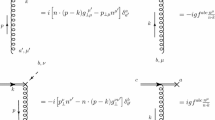Abstract
In the present article, two analytical solutions based on the Laplace transforms method for the linear and nonlinear gluon distribution functions have been presented at low values of x. These linear and nonlinear methods are presented based on the solutions of the Dokshitzer–Gribov–Lipatov–Altarelli–Parisi (DGLAP) evolution equation and the Gribov–Levin–Ryskin–Mueller–Qiu (GLR-MQ) equation at the leading-order accuracy in perturbative QCD, respectively. The gluon distributions are obtained directly in terms of the parameterization of structure function \(F_{2}(x,Q^{2})\) and its derivative and compared with the results from the parameterization models. The \(n_{f}\) changes at the threshold are considered in the numerical results. The effects of the nonlinear corrections are visible as \(Q^{2}\) decreases and vanish as \(Q^{2}\) increases. The nonlinear corrections tame the behavior of the gluon distribution function at low x and \(Q^{2}\) in comparison with the parameterization models.






Similar content being viewed by others
Notes
The standard parameterization of the gluon distribution function at low x is introduced by
$$\begin{aligned} G(x,Q^{2})=f(Q^{2})x^{-\delta } \end{aligned}$$where the low x behavior could well be more singular. By considering the variable change \(\nu {\equiv }\ln (1/x)\), one can rewrite the gluon distribution in s-space as
$$\begin{aligned} {\mathcal {L}}[\widehat{G}^{2}(\nu ,Q^{2});s]{=}\frac{f(Q^{2})^{2}}{(s-2\delta )},\\ {\mathcal {L}}[\widehat{G}(\nu ,Q^{2});s]^{2}{=}\frac{f(Q^{2})^{2}}{(s-\delta )^{2}}. \end{aligned}$$We observe that the function \({\mathcal {L}}[\widehat{G}^{2}(\nu ,Q^{2});s]\) is always lower than \({\mathcal {L}}[\widehat{G}(\nu ,Q^{2});s]^{2}\) for low s values in a wide range of \(Q^{2}\) values. According to this result, we use from this limited approach for solving the quadratic equation in s-space.
In Ref. [23], the gluon distribution for \(n_{f}=4\) is just \(\frac{3}{5}G_{n_{f}=3}(x,Q^{2})\), where \(G_{n_{f}=3}(x,Q^{2})\) is obtained from a fit to ZEUS data [25, 26] into an expression in both \(\ln (Q^{2})\) and \(\ln (1/x)\) to include the effects of heavy-quark masses. In Ref. [24], authors obtained an analytical solution for \(G(x,Q^{2})\) using a Froissart bounded structure function for \(0<x{\lesssim }0.09\). Those obtained a simple quadratic polynomial in \(\ln (1/x)\) with quadratic polynomial coefficients in \(\ln (Q^{2})\).
In Ref. [23], authors obtained the gluon distribution \(G(x,Q^{2})\) for 5 active quarks (for massless u, d, s and massive c, b quarks) into the massless gluon distribution \(G_{n_{f}=3}(x,Q^{2})\), as \(G_{n_{f}=5}(x,Q^{2})=\frac{6}{11}G_{n_{f}=3}(x,Q^{2})\). Also, authors obtained an excellent fit to the gluon distribution for \(n_{f}=5\) using a quadratic expression in \(\ln {1/x}\) and a much more complicated power series in \(\ln (Q^{2})\) for \(x{\lesssim }0.05\).
References
L.N. Lipatov, Sov. J. Nucl. Phys. 20, 94 (1975)
V.N. Gribov, L.N. Lipatov, Sov. J. Nucl. Phys. 15, 438 (1972)
G. Altarelli, G. Parisi, Nucl. Phys. B 126, 298 (1977)
Yu.L. Dokshitzer, Sov. Phys. JETP 46, 641 (1977)
H. Khanpour, A. Mirjalili, S. Atashbar Tehrani, Phys. Rev. C 95, 035201 (2017)
H. Khanpour, M. Goharipour, V. Guzey, Eur. Phys. J. C 78, 7 (2018)
S. Mohammad Moosavi Nejad, H. Khanpour, S. Atashbar Tehrani, M. Mahdavi, Phys. Rev. C 94, 045201 (2016)
G.R. Boroun, S. Zarrin, F. Teimoury, Eur. Phys. J. Plus 130, 214 (2015)
F. Teimoury Azadbakht, G.R. Boroun, Int. J. Theor. Phys. 57, 495 (2018)
S. Zarrin, G.R. Boroun, Nucl. Phys. B 922, 126 (2017)
F. Teimoury Azadbakht, G.R. Boroun, B. Rezaei, Int. J. Mod. Phys. E 27, 1850071 (2018)
M. Mottaghizadeh, F. Taghavi Shahri, P. Eslami, Phys. Lett. B 773, 375 (2017)
M. Mottaghizadeh, P. Eslami, F. Taghavi-Shahri, Int. J. Mod. Phys. A 32, 1750065 (2017)
S. Dadfar, S. Zarrin, Eur. Phys. J. C 80, 319 (2020)
H. Hosseinkhani, M. Modarres, N. Olanj, Int. J. Mod. Phys. A 32, 1750121 (2017)
M.M. Block, L. Durand, D.W. McKay, Phys. Rev. D 79, 014031 (2009)
LHeC Collaboration and FCC-he Study Group , P.Agostini et al., CERN-ACC-Note-2020-0002, J.Phys.G: Nucl.Part.Phys. 48, 110501(2021)
L.V. Gribov, E.M. Levin, M.G. Ryskin, Phys. Rept. 100, 1 (1983)
A.H. Mueller, J.W. Qiu, Nucl. Phys. B 268, 427 (1986)
A.V. Kotikov and V.N. Velizhanin, arXiv:math/0501274 [hep-ph] (2005)
F.D. Aaron et al., H1 and ZEUS collaborations. JHEP 1001, 109 (2010)
M.M. Block, L. Durand, P. Ha, Phys. Rev. D 89, 094027 (2014)
M.M. Block and L. Durand, arXiv:0902.0372 [hep-ph] (2009)
M.M. Block, L. Durand, D.W. McKay, Phys. Rev. D 77, 094003 (2008)
J. Breitweg et al., ZEUS. Phys. Lett. B 487, 53 (2000)
S. Chekanov et al., ZEUS. Eur. Phys. J. C 21, 443 (2001)
K.J. Eskola, H. Honkanen, V.J. Kolhinen, J.-W. Qiu, C.A. Salgado, Nucl. Phys. B 660, 211 (2003)
A. Dainese et al., HERA-LHC Workshop, DESY, (2005)
J. Pumplin et al., JHEP 07, 012 (2002)
Acknowledgements
I thank the respectable referee for giving the main idea of this work. I sincerely thank the EPJC referee for his/her invaluable comments during the review process my manuscript by Ref. NO. Eur. Phys. J. C 81 (2021) 9, 851. The feedback from the referee was very important for me.
Author information
Authors and Affiliations
Corresponding author
Appendix A
Appendix A
The explicit expression for the proton structure function suggested in Ref. [22] is defined by the following form
where
Here, M is the effective mass and \(\mu ^{2}\) is a scale factor. The additional parameters with their statistical errors are given in Table I.
Rights and permissions
About this article
Cite this article
Boroun, G.R. Analytic derivation of the nonlinear gluon distribution function. Eur. Phys. J. Plus 137, 259 (2022). https://doi.org/10.1140/epjp/s13360-022-02486-0
Received:
Accepted:
Published:
DOI: https://doi.org/10.1140/epjp/s13360-022-02486-0



